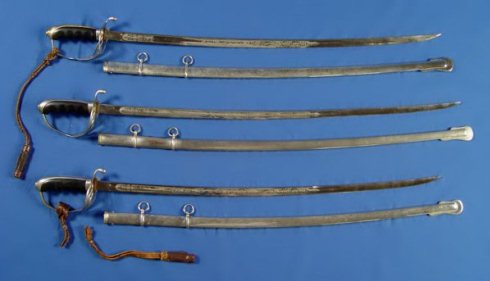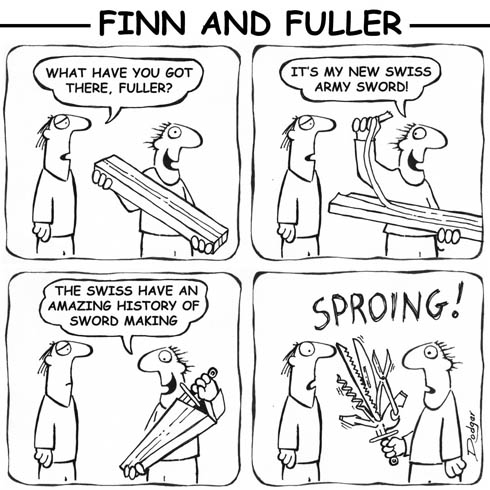| Back to Back Issues Page |
 |
|
Sword Buyers Digest - May 2012 May 01, 2012 |
| Hey,
This month’s issue including a new twist and challenge on how to cut tatami mats, Moniteur Tharp’s article on the Dueling Saber and a quick note from me about some downtime later this month. Anyway, hope you enjoy it!
1. From the Desk of Paul Southren
With stock levels running low across the board, batch 19 of the SBG custom Katana well underway and batch 18 for the most part shipped out (though we still have a few stragglers to go out, which should all be wrapped up by the end of the week) I feel that this month is a good opportunity to take a bit of a break.
Well, that and the fact that it is my daughters 5th birthday this month, my mother is here in Japan for a few weeks and I am also planning a short trip back to Australia towards the end of May means that it’s pretty much inevitable!
While things will be a little less hectic than usual during this downtime – one major project (that has ended up rather badly behind schedule as it proved to be much more technically challenging than first anticipated) is should hopefully come to fruition before my Australian trip – and that is the revitalization of the neglected sister site – Sword Manufacturers Guide.com.
Already a mirror site has been created and is currently being tested – and once this comes online I think you will find it to be a much more useful resource than before – a serious one stop shop for up to date brand information and news from both the makers and the buyers that I hope will help to revitalize the industry and provide the kind of transparency and accountability that we have been striving to create since day one.
Anyway, once my brief sabbatical is over and SMG is back on its feet and running at full steam I can turn my full attention to some other very exciting projects that I have been working on, some of which naturally involve the fact that I live in Japan – and others that involve a new format for this very monthly publication (don’t worry, it will still be free!) - but yes, more on this in due course..! ;-)
Moniteur Andrew (Drew) Tharp
In the late 1800’s, there was yet another fencing revolution led by the Italians. They, amongst others, noticed that the cavalry saber was beginning to wane in its usefulness as a weapon. The heavy cutting weapon was traditionally used from horseback, but was being replaced by the repeating revolver and other close range firearms. In response, sabers were being redesigned. This redesign was to make the weapon more fencible on foot, as well as lighter for ceremonies and formal events, and as a weapon for the duel. This change resulted in what is now aptly referred to as the “dueling saber.” The new weapon was much lighter, faster, and thinner, and is the direct ancestor of the modern fencing saber. In this feature I will outline the history and development of the dueling saber, and examine the American version – the M1902 Army Officers Saber. I will give information about options for finding a dueling saber and, in addition, I will be reviewing the recent publication from Moniteur Christopher A. Holzman – “The Art of the Dueling Sabre”- a translation and modern interpretation of Cav. Settimo Del Frate’s treatise on the Radaelli School of Sabre Fencing. One of my favorite “dueling” sabers that I have in my collection is an M1902 United States All Army Officers Saber. In 1902, there was a transition from the current issue sabers to the newly designed 1902. There is a fairly prominent view amongst sword collectors that this change was the signal that swords were officially no longer a weapon of war. Indeed the 1902 is much slighter and thinner than its previous counterparts (though we must include the famous “Patton” saber – which was indeed subsequent to the 1902). I do not agree with this view. I believe that this view is primarily tainted by collectors finding M1902’s from after the Second World War (the 1902 is still the pattern used by officers for drills and dress ceremonies today). At that time the 1902 became mostly ceremonial, generally mass produced out of stainless steel with Bakelite (or later, plastic) handles. But, the 1902 is not a pattern that is inherently ceremonial, as is demonstrated by several that I have found from before the First World War. These are often marked by a horn or wood grip and are generally Solingen produced. The sword that I own is from Solingen and was imported by Horstmann out of Philadelphia, and I assure you that it is a weapon in every sense of the word. The M1902 was not the first military style dueling saber. In fact, Moniteur Holzman has a fantastic breakdown of the Italian M1873. Major developments and changes were instituted by Cav. Frate when he took over the militaries fencing program. One of the primary developments was a change to teaching fencing more like his instructor – Guiseppe Radaelli. His pedagogical method relied on teaching the soldiers to fence on foot, then modifying that for use on horseback, showing a definite change in commanding officers minds about the usefulness of the cavalry. In addition, he changed the weapon itself, including flattening the thumb rest and making a noticeable bulge to accommodate the thumb in the guard. This allows the weapon to be held in a grip very similar to that of the modern fencing saber. It allows for more precise edge alignment and faster “finger fencing” (using the fingers and wrist to guide the weapon rather than the elbow and shoulder). Of course, this style of fencing does not work with the heavier cavalry styled sabers, so there is a new weapon in town. I have a great fascination with the dueling saber, so I will expand a little more on available options and what a good or bad sword might look like. An obvious choice is to find an antique – while probably the best choice, this is more difficult that it appears at first blush. Dueling sabers were not around for very long, and very often practitioners would merely use sport fencing weapons to approximate their live blades, meaning not a lot were made. There are few military models that work (like the U.S. M1902, the Italian M1873, and the Italian M1929), but they are of varying quality and still very hit or miss. So finding an antique can be very difficult. Modern reproductions are also very hit or miss. While the first that come to mind are the Hanwei dueling sabers, they have some substantial problems, most notably, the lack of curvature in the blade. In addition the blades are poorly profiled and not balanced correctly. The Hutton Sabre is slightly better, but still misses the mark with regards to blade length and thickness. In addition, forget about sharpening them for test cutting, as they are very soft. For training, I would almost recommend sticking to a modern fencing saber. It has substantial problems, including its light weight and lack of curvature, but for training, if actions are done with intention as demonstrated in Cav. Frate’s treatise, it will be a reasonable approximation for the time being. As for live blades, a few options spring to mind. The Cold Steel M1902 might be good – it certainly looks tough, but I worry that it is over built similarly to the other Cold Steel offerings. I will hopefully be acquiring one soon, and I will do a comparative review with my antique. In addition, Cold Steel offers their Gentleman’s Saber, which is clearly trying to appeal to a dueling saber demographic. Their previous incarnation failed, with a blade that could not be sharpened, but their newer generation might do better, I have not seen it yet. In my collection, I have a dueling saber that was made by Michael Tinker Pearce. It is one of my absolute favorite blades, but it still has historical issues. To be fair, it was never requested that Tinker stick to historical parameters, so it essentially more of a fantasy piece. It is absolutely perfect when it comes to feel though, precisely what I want a dueling saber to feel like. If I were looking for a fantastic historical dueling blade, I would find measurements from an original and send them to Tinker without a doubt in my mind. But alas, dueling sabers replicas are not thick on the ground. The best option currently seems to be going custom. With that in mind, I know Moniteur Holzman is working hard on creating a new replica that would be made to his antique’s dimensions. When that saber comes out, I have no doubt it will be the best on the market. In addition, I see some promise in the Cold Steel 1902, but it is likely not perfect. I will keep the forum updated with all of my findings. Thus, the dueling saber could be dubbed the “missing link” in the evolution of modern fencing. Many students of the current school wonder how their training translates to the cavalry saber of the mid-18th and 19th centuries. The answer is, quite definitely, it doesn’t. It does transfer very readily to use with the dueling saber, though. For those looking for more information on the dueling saber it is very easy for me to say that Moniteur Holzman’s treatise is the best modern treatise on dueling saber. Since it is the only modern treatise on dueling saber, I will be reviewing it from a historical fencing light. How does it compare to other historical fencing books available today? To be blunt, it is one of the best historical fencing books available today. It does have some issues, and is likely not for beginners, but Moniteur Holzman is one of the best writers I have seen in the historical fencing arena. The translations in the book are easy to read, and Moniteur Holzman takes his extensive experience and applies it to the older readings with ease. In addition, the fold-out plates are beautifully done and add to the experience of reading the book greatly. Moniteur Holzman’s introduction gives a glimpse into the history and reason for studying these Masters, as well as indicating why these changes were made to the study and practice of saber in the late 1800’s. The book is beautifully bound, but does have a substantial price tag. At $42.95 (retail) I would have appreciated a better system for holding in the fold-outs, and possibly color pictures where possible. In addition, as an instructional book, The Art of the Dueling Saber falls a little flat. I would love to see an expanded edition which has images of Moniteur Holzman and a student performing drills and techniques, rather than an entirely textually based description. While the fold-out plates are great illustrations, I believe that modern pedagogical techniques demand a slightly different tactic. The real jewel of the book are Montieur Holzman’s expanded synoptic tables, which quickly and accurately make the art complete. I would expect that by practicing and understanding these tables completely, a student could become proficient in the dueling saber. That is something that most other treatises do not offer, generally making students fill in some blanks on their own. In short, this is a great book on swordmanship, and a must for students of historical fencing and modern fencing alike. The dueling saber is a fascinating topic for study. It is both a weapon for war, but still used in the duel. It was both a sport and a martial art. This art has the brutality, power generation, and violence of action that makes it a realistic military fighting system, while retaining a surprising amount of finesse that hints at the future of fencing. This time of transition in the late 1800’s should be of interest to all swordsmen. For modern fencers, studying their own history, Moniteur Holzman’s treatise is absolutely invaluable to understand our passion. On the other hand, for historical fencers looking to understand the appeal of modern fencing, and wanting a slightly faster paced game, dueling saber is an absolute must. For scholars, Moniteur Holzman’s treatise is one of the best written and well researched I have ever seen. The Art of the Dueling Sabre by Moniteur Christopher Holzman is available from SKA Swordplay Books By Moniteur Andrew (Drew) Tharp – Drew is the Senior Fencing Instructor at Indiana University, has a Certification in Martial Arts from IU, and has been collecting swords since the late 90’s. He currently practices Longsword, Iaido, and Tai Chi Chuan in addition to Fencing.
This month’s video is from one of my favourite TV shows here in Japan – and while it is entirely in Japanese, you don’t need to understand the language to appreciate the awesomeness of it.. We featured some of the skills of the ‘modern day Samurai’ Isao Machii in a previous Video of the Month but this one takes it to a whole new level. The first section shows his Guinness Book of Records breaking attempt for 1,000 cuts to tatami mats in the shortest time – the second, cutting a free standing mat without it falling – 7 times.. And then some video of cutting a variety of targets (including a soft ball launched at 120kmph)…
SORRY - VIDEO NO LONGER AVAILABLE
Best of luck cutting those free standing Tatami mats!
SBG Sword Store While the general trend has been for the sword industry to be INCREASING prices for the last several months (Hanwei, Gen 2/Legacy Arms, etc) and there haven’t been as many specials around as there was previously, late last month we added a new product to our line up from Darksword Armory – the stunning LoTR inspired Witchking sword. I had always liked the look of this sword from when I first laid eyes on it, so when DSA brought out their take on it in March I was seriously excited – and from now until the 10th of May you can pick it up with a 10% discount. Simply enter the coupon code ‘May Special’ in the checkout and we will deduct 10% off the price (making this a seriously good deal, as we offer FREE SHIPPING in the USA and Canada). Check it out in all it’s dark glory here
That’s it for the May issue – I think that as I am coming back from Australia on the 25th and will have a lot of stuff to catch up on the June issue may be just a little lighter than usual, but I’ll do my best to bring you a worthwhile read next month – so until then, happy swordening folks! Paul Southren
|
| Back to Back Issues Page |
 Welcome to the May edition of the digest – glad you could join me!
Welcome to the May edition of the digest – glad you could join me!


